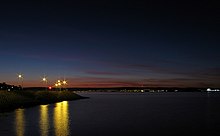Belfast Lough
| Belfast Lough Loch Lao(Irish) Bilfawst Loch(Ulster-Scots)[1] | |
|---|---|
 Satellite photo | |
| Location | Northern Ireland |
| Coordinates | 54°41′28″N5°47′06″W/ 54.691°N 5.785°W |
| Designated | 5 August 1998 |
| Reference no. | 958[2] |




Belfast Lough(Irish:Loch Lao) is a large, intertidal sea inlet on the east coast ofNorthern Ireland.At its head is the city andportofBelfast,which sits at the mouth of theRiver Lagan.Theloughopens into theNorth Channeland connects Belfast to theIrish Sea.
Belfast Lough is a long, wide and deep expanse of water, virtually free of strong tides. The inner part of the lough comprises a series of mudflats and lagoons. The outer lough is restricted to mainly rocky shores with some small sandy bays. The outer boundary of the lough is a line joining Orlock Point and Blackhead.
The main coastal towns areBangoron the southern shore (County Down) andCarrickferguson the northern shore (County Antrim). Other coastal settlements includeHolywood,Helen's Bay,GreenislandandWhitehead.
Name
[edit]Belfast Lough is known in Irish asLoch Lao,which was Anglicised as 'Lough Lee'. Earlier spellings includeLoch LaoighandLoch Laigh.This name means "sea inlet of the calf". The River Lagan, which flows into it, was also historically known as theLao.It is believed that the lough and river were named after a "bovine goddess". In the 2nd century, the Greek geographerPtolemyreferred to it as theLogia.[3]
Before Belfast grew into a city, the lough was known in English as 'Carrickfergus Bay'. InUlster-Scotsit is calledBilfawst LochorCraigfergus Loch.[4][5]
History
[edit]In 1689 during theWar of the Two KingstheWilliamiteexpeditionary force underMarshal Schomberglanded atBangor,after the lough had been cleared of French shipping byGeorge Rooke.Schomberg occupied the towns of Bangor and Belfast, before successfullylaying siege to Carrickfergus.The following yearWilliam IIIalso used the lough as a safe anchorage when he arrived in Ireland with reinforcements for Schomberg in the run-up to the victory over theJacobitearmy at theBattle of the Boyne.
Wildlife
[edit]Nature reserve
[edit]The "inner lough" was made an Area of Special Scientific Interest (ASSI) in 1987. Recorded wildlife includesCrepidula fornicataLamarck (Slipper Limpet).[6][7]
Ramsar site
[edit]The Belfast Lough Ramsar site (wetlands of international importance designated under theRamsar Convention), is 432.14 hectares in area, at latitude 54 38 00 N and longitude 05 54 00 W. It was designated a Ramsar site on 5 August 1998.[8]
In the outer lough, the Ramsar boundary entirely coincides with that of Outer Belfast LoughArea of Special Scientific Interestbut within the immediate harbour area the boundary has been redrawn to take into account permitted port related development and landfill which has taken place since the Inner Belfast Lough Area of Special Scientific Interest was declared in 1987. Marine areas below mean low water are not included. The Ramsar boundary entirely coincides with that of the Belfast LoughSpecial Protection Area.The site qualifies under Criterion 3c of the Ramsar Convention by regularly supporting internationally important numbers ofcommon redshankin winter. The site also regularly supports nationally important numbers ofcommon shelduck,Eurasian oystercatcher,purple sandpiper,dunlin,black-tailed godwit,bar-tailed godwit,Eurasian curlewandruddy turnstone.[9]In recent years, Otters have been seen more regularly on the lough shores.[10][11][12]
Sailing
[edit]Popular for sailing, the lough has three marinas: one atBangor,one atCarrickfergusand a third located atTitanic Quarter.Belfast docks at the head of a lough contain the famous shipbuilder of theRMSTitanicfame,Harland & Wolff,who are no longer building ships for the foreseeable future and has shed most of its workforce and diversified into repairing and refitting large tankers and oilrigs.Coastguardoffices for the lough, although referred to asBelfast Coastguard,are in the town of Bangor by the marina. In 1912, the RMS Titanic sailed down the lough from Belfast to the Irish Sea for its sea trials.
The lough hosts two Royal Yacht Clubs. These include theRoyal North of Ireland Yacht Club,atCultrajust outsideHolywood,and theRoyal Ulster,which is based fromBangor.There are also several other sailing clubs around the lough, many of which are members of theBelfast Lough Yachting Conference.[citation needed]
The lough has 30 square miles (78 km2) of open water and enough coastline to make short inshore races day-long affairs.[citation needed]Three main arteries serve the lough close to Belfast: the Herdman Channel on theCounty Antrimcoast side; the Victoria Channel, the central and longest route; and the Musgrave Channel on theCounty Downside.
Railway
[edit]TheBelfast-Larne railway lineskirts the north shore particularly fromCarrickfergusand thenDownshiretoWhiteheadand northwards then alongsideLarne LoughtoLarne Harbour.Trains connectBelfast Grand CentralandBelfast Lanyon Placeto Larne Harbour.
TheBelfast-Bangor railway lineskirts the south shore atHolywood railway stationtoMarino railway stationandCultra railway station.Trains connect Belfast Grand Central; and Belfast Lanyon Place toBangor.
Cultra railway station is the home of theUlster Folk and Transport Museum.
See also
[edit]References
[edit]- ^"Blackbird Festival"(PDF).Forbairt Feirste. Archived fromthe original(PDF)on 25 April 2012.Retrieved10 April2017.
- ^"Belfast Lough".RamsarSites Information Service.Archivedfrom the original on 30 May 2018.Retrieved25 April2018.
- ^"PlaceNames NI: Belfast Lough".Archivedfrom the original on 31 May 2020.Retrieved21 January2015.
- ^A Wurd o WalcomeArchived25 April 2012 at theWayback MachineBlackbird Festival. Retrieved 20 October 2011.
- ^The Online Scots DictionaryArchived9 July 2010 at theWayback MachineRetrieved 21 August 2012.
- ^Guy, Claire,G. Reid, N. and Roberts, D. 2013. Ageing of Slipper Limpet (Crepidula fornicate) shells from Belfast Lough.Ir Nat J.32:45 – 48
- ^Scott, R. 2004.Wild Belfast on safari in the city.Blackstaff Press.ISBN0 85640 762 3
- ^"Designated and Proposed Ramsar sites in Northern Ireland"(PDF).Joint Nature Conservation Committee.Archived(PDF)from the original on 7 March 2012.Retrieved7 July2008.
- ^"Belfast Lough Ramsar site".NI Environment Agency.Archived fromthe originalon 5 August 2012.Retrieved7 July2008.
 This article incorporates text published under the BritishOpen Government Licence:
This article incorporates text published under the BritishOpen Government Licence:
- ^Otter feeding and leaving spraints, Belfast Lough, 21/06/2022,retrieved8 December2023
- ^Armstrong, Betty."Bangor Harbour is Alive With Marine Wildlife".afloat.ie.Retrieved8 December2023.
- ^"Carrick Dog Walker encounters Otter".Northern Ireland World.2015.

![Belfast Lough Loch Lao (Irish) Bilfawst Loch (Ulster-Scots)[1] is located in Greater Belfast](https://upload.wikimedia.org/wikipedia/commons/thumb/e/e9/GreaterBelfastTemplate.gif/256px-GreaterBelfastTemplate.gif)

